Performance of Hybrid Strengthening System for Reinforced Concrete Member Using CFRP Composites Inside and over Transverse Groove Technique
Abstract
Highlights
- A hybrid system has been implemented by combining CFRP fabric bonded inside transverse grooves (EBRITG) with externally bonded layers over the grooves (EBROTG).
- Results demonstrated significant flexural capacity improvement—57% and 72.5% improvement with two and three CFRP layers, respectively—compared to the EBROG method, confirming the superior bonding efficiency.
- Combining CFRP fabric using EBRITG with EBROTG method prevent the delamination of CFRP and significantly improved the bonding strength.
- Anchoring the concrete cover in the hybrid system has significantly enhanced the flexural performance of the strengthened beams.
Abstract
1. Introduction
2. Experimental Program
2.1. Specimens Details
2.2. Materials Properties
2.3. Specimen Fabrication and Strengthening
2.4. Test Configuration and Setup
3. Experimental Results and Discussion
3.1. Load Capacity and Failure Modes
3.1.1. B2 Specimen
3.1.2. B3 and B4 Specimens
3.1.3. B5 Specimen
3.1.4. B6 and B7 Specimens
3.2. Strain Values
4. Conclusions
- The EBROG method exhibited CFRP delamination initiating at the fiber end and propagating to the mid-span. The ultimate load capacity reached 73.76 kN, a 22% increase over the reference beam (60.4 kN).
- The EBRIG method showed minimal strength improvement (61.35 kN), attributed to the fiber discontinuity at the grooves, which disrupted the tension resistance and promoted crack propagation.
- The hybrid system (EBRIG + EBROG) achieved a modest load increase (72 kN) due to a premature concrete cover separation.
- Anchoring the concrete cover in the hybrid system significantly enhanced the performance: two layers (one EBRIG + one EBROG) increased in capacity by 57% (94 kN), while three layers (one EBRIG + two EBROG) achieved a 72.5% increase (104.27 kN).
- The strain evolution analysis confirmed the CFRP’s contribution to the stiffness and load capacity, with the bonding-zone effectiveness improving alongside the layer count.
Author Contributions
Funding
Data Availability Statement
Acknowledgments
Conflicts of Interest
References
- Meier, U. Strengthening of structures using carbon fibre/epoxy composites. Constr. Build. Mater. 1995, 9, 341–351. [Google Scholar] [CrossRef]
- Yao, J.; Teng, J. Plate end debonding in FRP-plated RC beams—I: Experiments. Eng. Struct. 2007, 29, 2457–2471. [Google Scholar] [CrossRef]
- Tajmir-Riahi, A.; Moshiri, N.; Mostofinejad, D. Inquiry into bond behavior of CFRP sheets to concrete exposed to elevated temperatures–Experimental & analytical evaluation. Compos. Part B Eng. 2019, 173, 106897. [Google Scholar]
- Gao, P.; Gu, X.; Mosallam, A.S. Flexural behavior of preloaded reinforced concrete beams strengthened by prestressed CFRP laminates. Compos. Struct. 2016, 157, 33–50. [Google Scholar] [CrossRef]
- Guipeng, C.; Yanlie, W.; Shutong, Y. Elliptical FRP–concrete–steel double-skin tubular columns under cyclic compression: Fundamental characteristics and modeling. Eng. Struct. 2025, 326, 119517. [Google Scholar]
- Martinelli, E.; Hosseini, A.; Ghafoori, E.; Motavalli, M. Behavior of prestressed CFRP plates bonded to steel substrate: Numerical modeling and experimental validation. Compos. Struct. 2019, 207, 974–984. [Google Scholar] [CrossRef]
- Hosseini, A.; Nussbaumer, A.; Motavalli, M.; Zhao, X.-L.; Ghafoori, E. Mixed mode I/II fatigue crack arrest in steel members using prestressed CFRP reinforcement. Int. J. Fatigue 2019, 127, 345–361. [Google Scholar] [CrossRef]
- Mosallam, A.; Banerjee, S. Enhancement in in-plane shear capacity of unreinforced masonry (URM) walls strengthened with fiber reinforced polymer composites. Compos. Part B Eng. 2011, 42, 1657–1670. [Google Scholar] [CrossRef]
- Hosseini, A.; Mostofinejad, D.; Emami, M. Influence of bonding technique on bond behavior of CFRP-to-clay brick masonry joints: Experimental study using particle image velocimetry (PIV). Int. J. Adhes. Adhes. 2015, 59, 27–39. [Google Scholar] [CrossRef]
- Ali, A.; Abdalla, J.; Hawileh, R.; Galal, K. CFRP mechanical anchorage for externally strengthened RC beams under flexure. Phys. Procedia 2014, 55, 10–16. [Google Scholar] [CrossRef]
- Yu, P.; Silva, P.F.; Nanni, A. Description of a mechanical device for prestressing of carbon fiber-reinforced polymer sheets-Part I. ACI Struct. J. 2008, 105, 3–10. [Google Scholar]
- Michels, J.; Martinelli, E.; Czaderski, C.; Motavalli, M. Prestressed CFRP strips with gradient anchorage for structural concrete retrofitting: Experiments and numerical modeling. Polymers 2014, 6, 114–131. [Google Scholar] [CrossRef]
- Pham, H.B.; Al-Mahaidi, R. Prediction models for debonding failure loads of carbon fiber reinforced polymer retrofitted reinforced concrete beams. J. Compos. Constr. 2006, 10, 48–59. [Google Scholar] [CrossRef]
- Kim, Y.J.; Wight, R.G.; Green, M.F. Flexural strengthening of RC beams with prestressed CFRP sheets: Development of nonmetallic anchor systems. J. Compos. Constr. 2008, 12, 35–43. [Google Scholar] [CrossRef]
- Michels, J.; Sena-Cruz, J.; Czaderski, C.; Motavalli, M. Structural strengthening with prestressed CFRP strips with gradient anchorage. J. Compos. Constr. 2013, 17, 651–661. [Google Scholar] [CrossRef]
- Bilotta, A.; Ceroni, F.; Di Ludovico, M.; Nigro, E.; Pecce, M.; Manfredi, G. Bond efficiency of EBR and NSM FRP systems for strengthening concrete members. J. Compos. Constr. 2011, 15, 757–772. [Google Scholar] [CrossRef]
- Hajihashemi, A.; Mostofinejad, D.; Azhari, M. Investigation of RC beams strengthened with prestressed NSM CFRP laminates. J. Compos. Constr. 2011, 15, 887–895. [Google Scholar] [CrossRef]
- Nordin, H.; Täljsten, B. Prestressed near surface mounted reinforcement (NSMR) for strengthening concrete beams. In FRP Composites in Civil Engineering-CICE 2004: Proceedings of the 2nd International Conference on FRP Composites in Civil Engineering—CICE 2004, Adelaide, Australia, 8–10 December 2004; CRC Press: Boca Raton, FL, USA, 2002; p. 447. [Google Scholar]
- Al-Abdwais, H.; Al-Mahaidi, R. Experimental and finite element analysis of flexural performance of RC beams retrofitted using near-surface mounted with CFRP composites and cement adhesive. Eng. Struct. 2021, 241, 112429. [Google Scholar] [CrossRef]
- AL-Abdwais, H.; Al-mahaidi, R. Performance of NSM CFRP strengthened concrete using modified cement-based adhesive at elevated temperature. Constr. Build. Mater. 2017, 132, 296–302. [Google Scholar] [CrossRef]
- Al-Abdwais, H.; Al-Mahaidi, R. Performance of reinforced concrete beams strengthened with NSM CFR Composites for flexure using cement-based adhesives. Struct. J. 2020, 27, 1446–1457. [Google Scholar] [CrossRef]
- Mostofinejad, D.; Mahmoudabadi, E. Grooving as alternative method of surface preparation to postpone debonding of FRP laminates in concrete beams. J. Compos. Constr. 2010, 14, 804–811. [Google Scholar] [CrossRef]
- Mostofinejad, D.; Shameli, S.M.; Hosseini, A. EBROG and EBRIG methods for strengthening of RC beams by FRP sheets. Eur. J. Environ. Civ. Eng. 2014, 18, 652–668. [Google Scholar] [CrossRef]
- Moshiri, N.; Tajmir-Riahi, A.; Mostofinejad, D.; Czaderski, C.; Motavalli, M. Experimental and analytical study on CFRP strips-to-concrete bonded joints using EBROG method. Compos. Part B Eng. 2019, 158, 437–447. [Google Scholar] [CrossRef]
- Tajmir-Riahi, A.; Moshiri, N.; Mostofinejad, D. Bond mechanism of EBROG method using a single groove to attach CFRP sheets on concrete. Constr. Build. Mater. 2019, 197, 693–704. [Google Scholar] [CrossRef]
- Shomali, A.; Mostofinejad, D.; Esfahani, M.R. Experimental and numerical investigation of shear performance of RC beams strengthened with FRP using grooving method. J. Build. Eng. 2020, 31, 101409. [Google Scholar] [CrossRef]
- Mostofinejad, D.; Hosseini, S.A.; Razavi, S.B. Influence of different bonding and wrapping techniques on performance of beams strengthened in shear using CFRP reinforcement. Constr. Build. Mater. 2016, 116, 310–320. [Google Scholar] [CrossRef]
- Czaderski, C.; Moshiri, N.; Hosseini, A.; Mostofinejad, D.; Motavalli, M. EBROG technique to enhance the bond performance of CFRP strips to concrete substrate. In Proceedings of the SMAR 2019-Fifth Conference on Smart Monitoring, Assessment and Rehabilitation of Civil Structures, Berlin, Germany, 27–29 August 2019. [Google Scholar]
- Moshiri, N.; Hosseini, A.; Mostofinejad, D. Strengthening of RC columns by longitudinal CFRP sheets: Effect of strengthening technique. Constr. Build. Mater. 2015, 79, 318–325. [Google Scholar] [CrossRef]
- Mostofinejad, D.; Moshiri, N. Compressive strength of CFRP composites used for strengthening of RC columns: Comparative evaluation of EBR and grooving methods. J. Compos. Constr. 2014, 19, 04014079. [Google Scholar] [CrossRef]
- NoroozOlyaee, M.; Mostofinejad, D. Slenderness Effects in Circular RC Columns Strengthened with CFRP Sheets Using Different External Bonding Techniques. J. Compos. Constr. 2019, 23, 04018068. [Google Scholar] [CrossRef]
- Ilia, E.; Mostofinejad, D. Seismic retrofit of reinforced concrete strong beam–weak column joints using EBROG method combined with CFRP anchorage system. Eng. Struct. 2019, 194, 300–319. [Google Scholar] [CrossRef]
- Tajmir-Riahi, A.; Mostofinejad, D.; Moshiri, N. Bond resistance of a single groove in EBROG method to attach CFRP sheets on concrete. In Proceedings of the Ninth International Conference on Fibre-Reinforced Polymer (FRP) Composites in Civil Engineering (CICE 2018), Paris, France, 17–19 July 2018; pp. 368–373. [Google Scholar]
- Hosseini, A.; Mostofinejad, D. Experimental investigation into bond behavior of CFRP sheets attached to concrete using EBR and EBROG techniques. Compos. Part B Eng. 2013, 51, 130–139. [Google Scholar] [CrossRef]
- Moshiri, N.; Mostofinejad, D.; Tajmir-Riahi, A. Bond behavior of pre-cured CFRP strips to concrete using externally bonded reinforcement on groove (EBROG) method. In Proceedings of the Ninth International Conference on Fibre-Reinforced Polymer (FRP) Composites in Civil Engineering (CICE 2018), Paris, France, 17–19 July 2018; pp. 361–367. [Google Scholar]
- Moshiri, N.; Czaderski, C.; Mostofinejad, D.; Motavalli, M. Bond strength of prestressed CFRP strips to concrete substrate: Comparative evaluation of EBR and EBROG methods. In Proceedings of the SMAR 2019-Fifth Conference on Smart Monitoring, Assessment and Rehabilitation of Civil Structures, Berlin, Germany, 27–29 August 2019. [Google Scholar]
- Mostofinejad, D.; Mohammadi, M. Effect of Freeze–Thaw Cycles on FRP-Concrete Bond Strength in EBR and EBROG Systems. J. Compos. Constr. 2020, 24, 04020009. [Google Scholar] [CrossRef]
- Tajmir-Riahi, A.; Moshiri, N.; Mostofinejad, D. EBROG method to strengthen heat751damaged concrete with CFRP sheets. In Proceedings of the SMAR 2019-Fifth Conference on Smart Monitoring, Assessment and Rehabilitation of Civil Structures, Berlin, Germany, 27–29 August 2019. [Google Scholar]
- Moghaddas, A.; Mostofinejad, D. Empirical FRP-Concrete Bond Strength Model for Externally Bonded Reinforcement on Grooves. J. Compos. Constr. 2018, 23, 04018080. [Google Scholar] [CrossRef]
- Heydari Mofrad, M.; Mostofinejad, D.; Hosseini, A. A generic non-linear bond-slip model for CFRP composites bonded to concrete substrate using EBR and EBROG techniques. Compos. Struct. 2019, 220, 31–44. [Google Scholar] [CrossRef]
- Tajmir-Riahi, A.; Moshiri, N.; Czaderski, C.; Mostofinejad, D. Effect of the EBROG method on strip-to-concrete bond behavior. Constr. Build. Mater. 2019, 220, 701–711. [Google Scholar] [CrossRef]
- Michels, J.; Zile, E.; Czaderski, C.; Motavalli, M. Debonding failure 761 mechanisms in prestressed CFRP/epoxy/concrete connections. Eng. Fract. Mech. 2014, 132, 16–37. [Google Scholar] [CrossRef]
- Moshiri, N.; Czadersk, C. Flexural strengthening of RC slabs with non prestressed and prestressed CFRP strips using EBROG method. Compos. Part B Eng. 2020, 201, 108359. [Google Scholar] [CrossRef]
- Moghaddas, A.; Mostofinejad, D. An empirical FRP-concrete bond-slip model for externally-bonded reinforcement on grooves. Constr. Build. Mater. 2021, 281, 122575. [Google Scholar] [CrossRef]
- Mostofinejad, D.; Shameli, S.M. Externally bonded reinforcement in grooves (EBRIG) technique to postpone debonding of FRP sheets in strengthened concrete beams. Constr. Build. Mater. 2013, 38, 751–758. [Google Scholar] [CrossRef]
- Abdel-Kareem, A.H.; Elprince, M.; Makhlouf, M.H. Structural performance of RC beams with openings shear strengthened by hybrid techniques (EBR/EBRIG). Eur. J. Environ. Civ. Eng. 2024, 28, 1637–1657. [Google Scholar] [CrossRef]
- Al-Abdwais, A.; Al-Tamimi, K. Evaluation of bonding properties between CFRP laminate and concrete using externally bonded reinforcement on transverse grooves (EBROTG) method. J. Compos. Sci. 2024, 8, 488. [Google Scholar] [CrossRef]
- ASTM C39/C39M-18; Standard Test Method for Compressive Strength of Cylindrical Concrete Specimens. ASTM International: West Conshohocken, PA, USA, 2017.
- Mapei Construction Chemical Production Company. UAE. Available online: https://www.mapei.com/ae/en/about-us/mapei-in-uae (accessed on 15 July 2024).
- ASTM D3039/D3039M-17; Standard Test Method for Tensile Properties of Polymer Matrix Composite Materials. ASTM International: West Conshohocken, PA, USA, 2017.
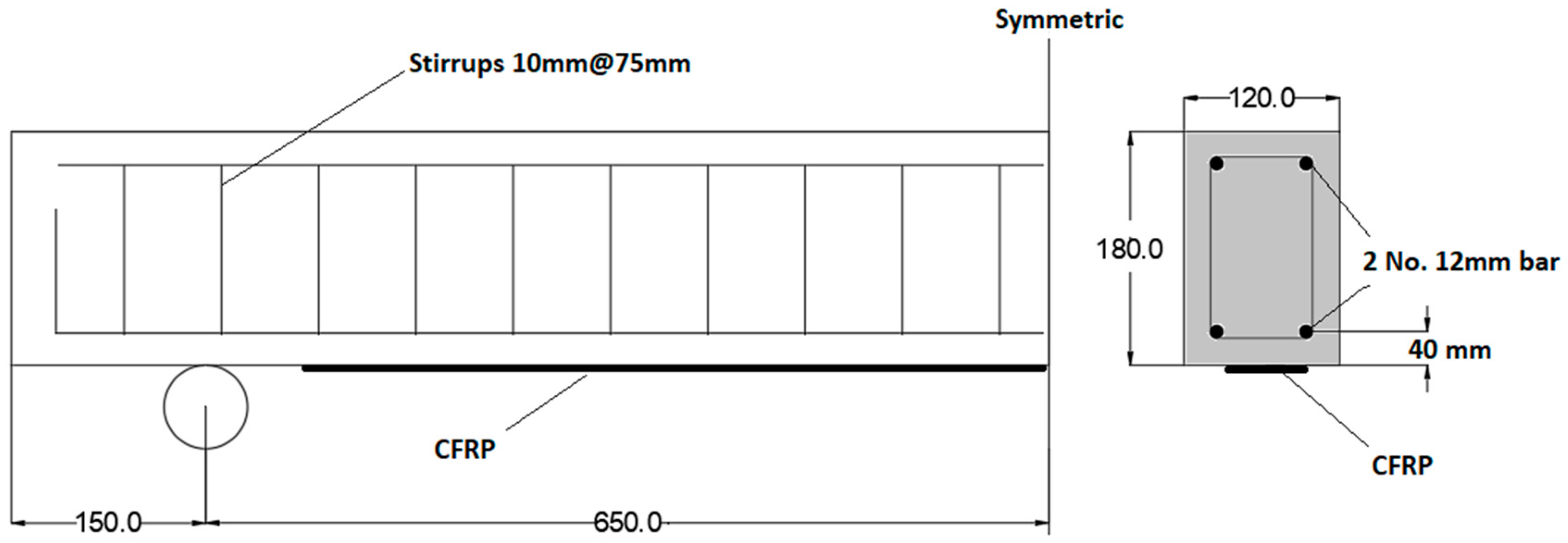

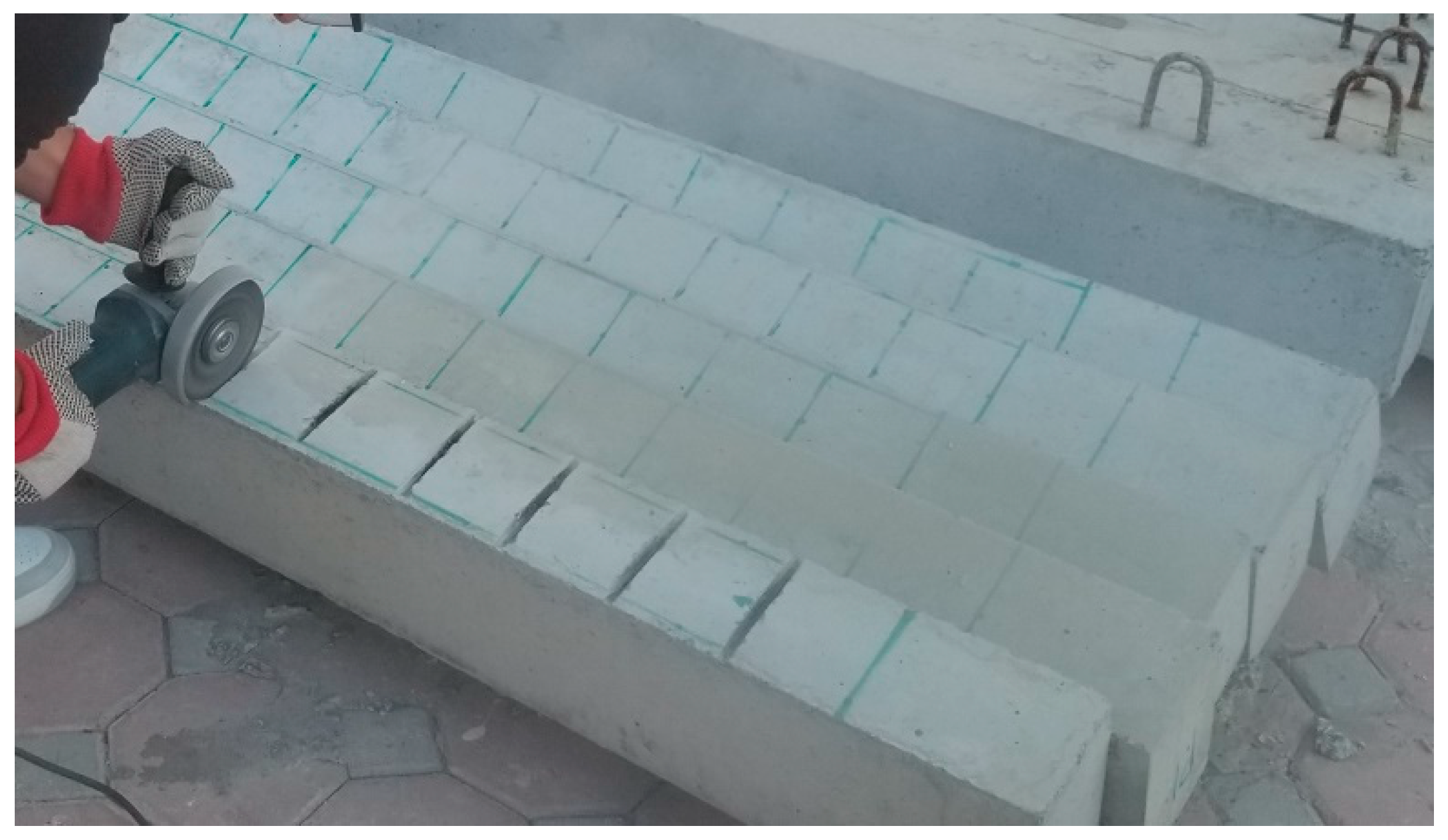
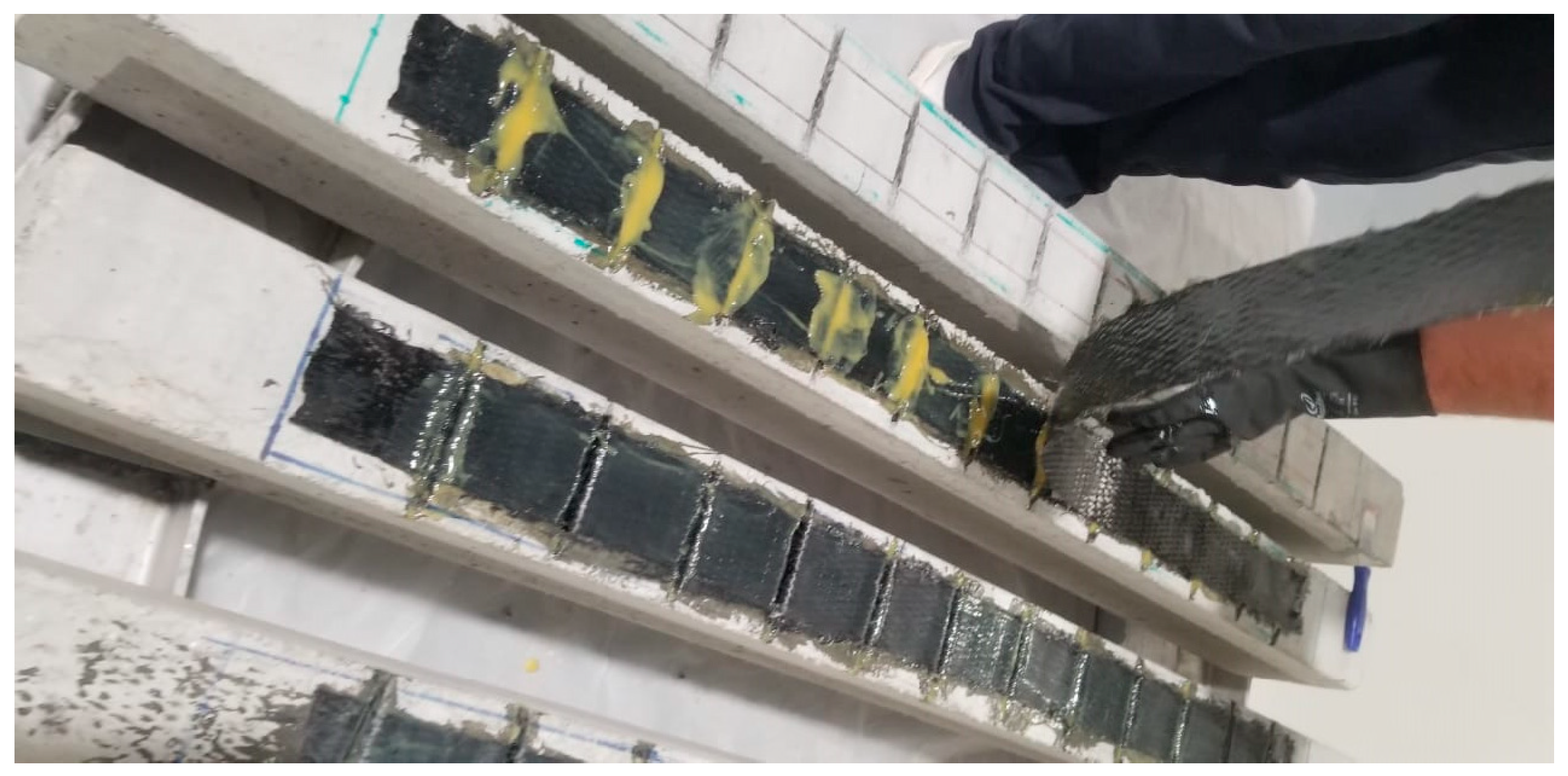
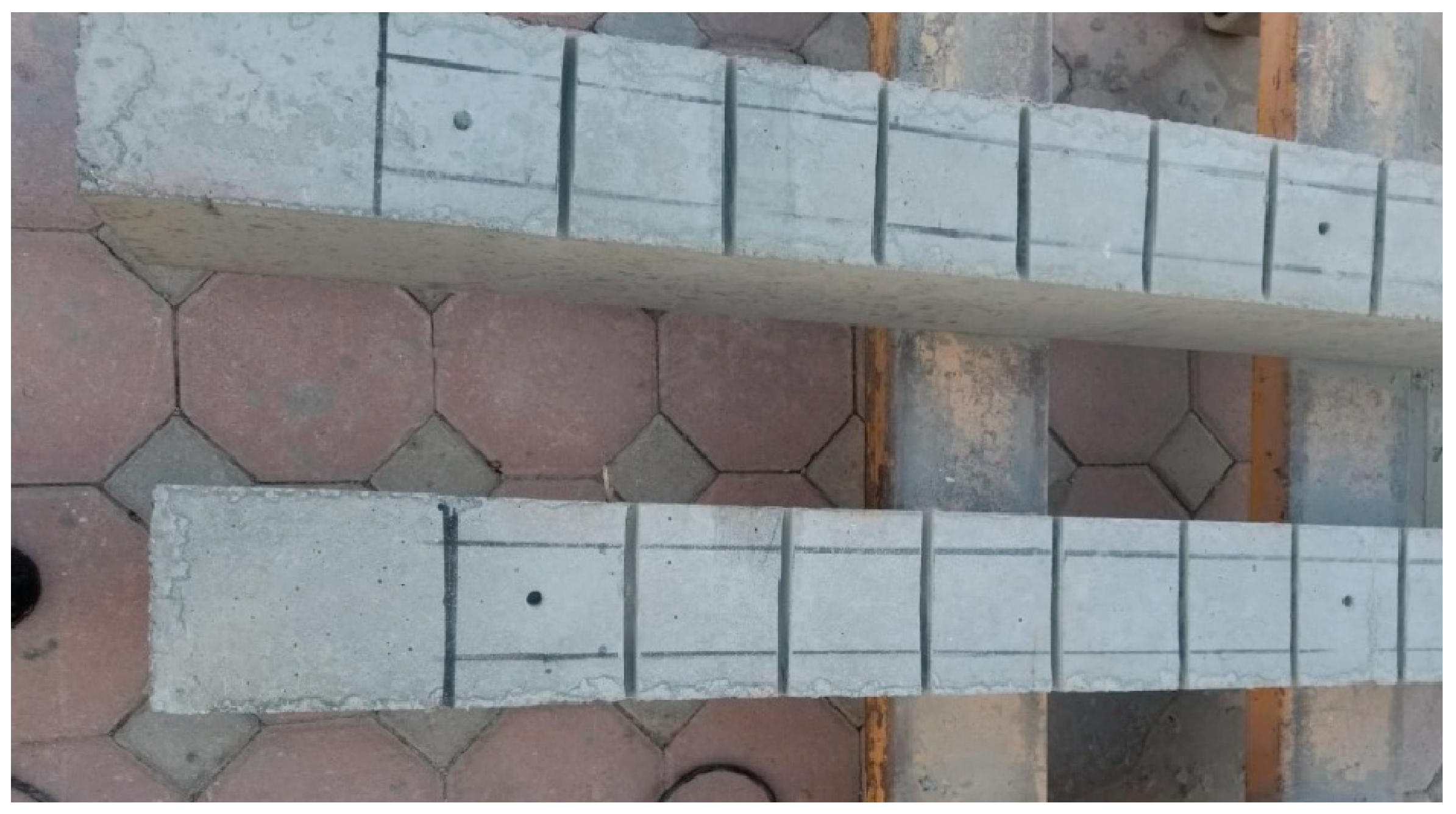

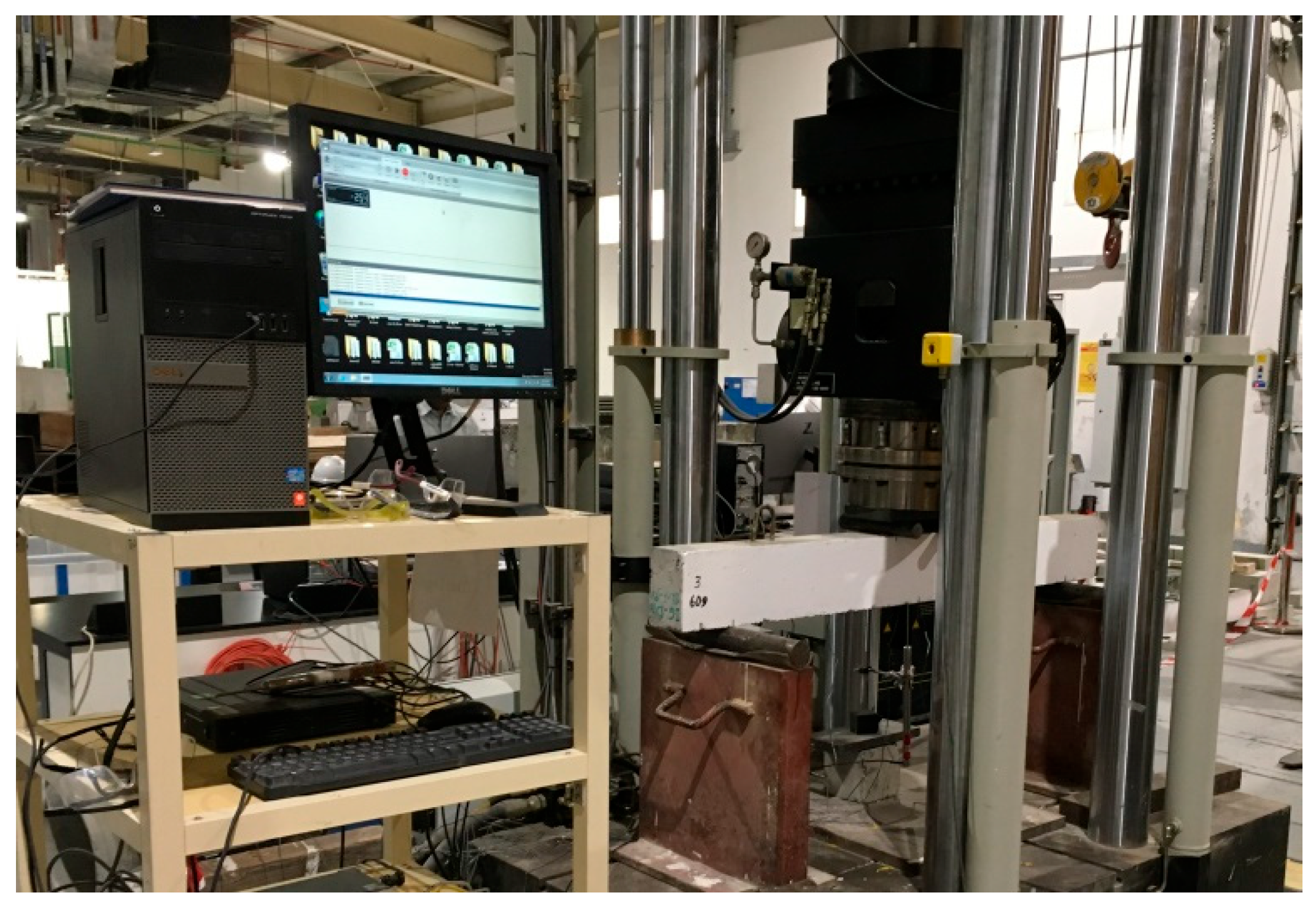

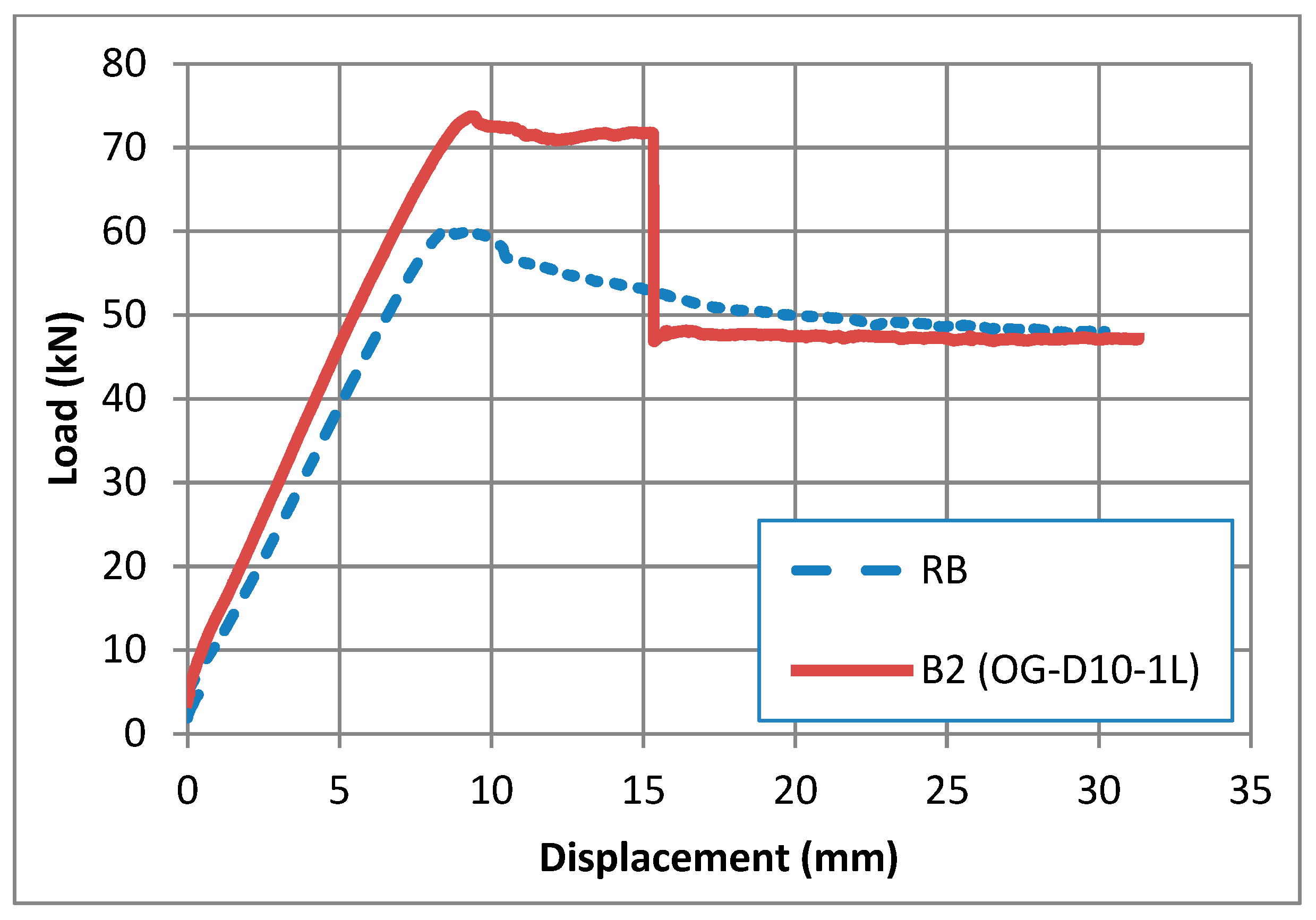
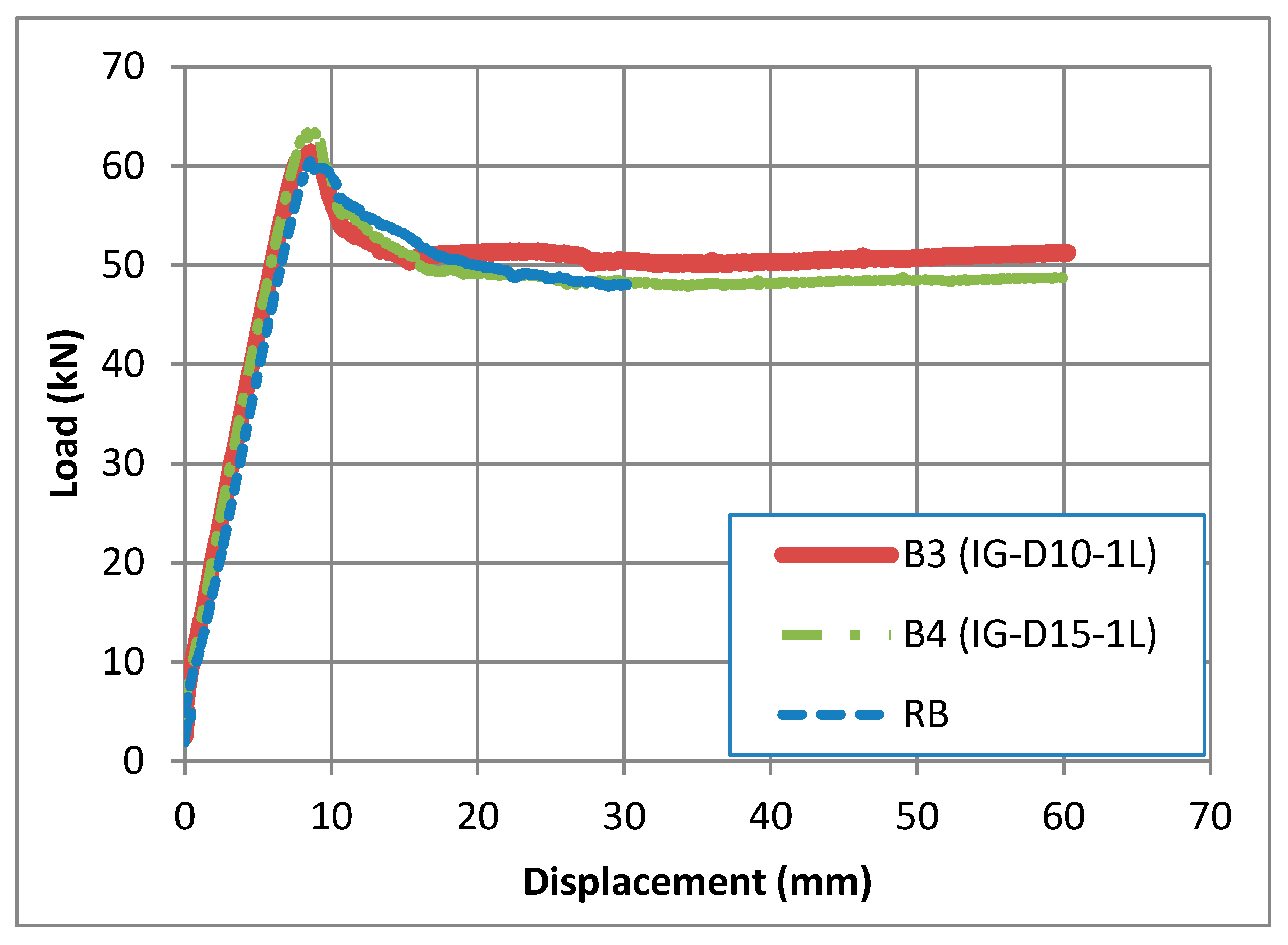
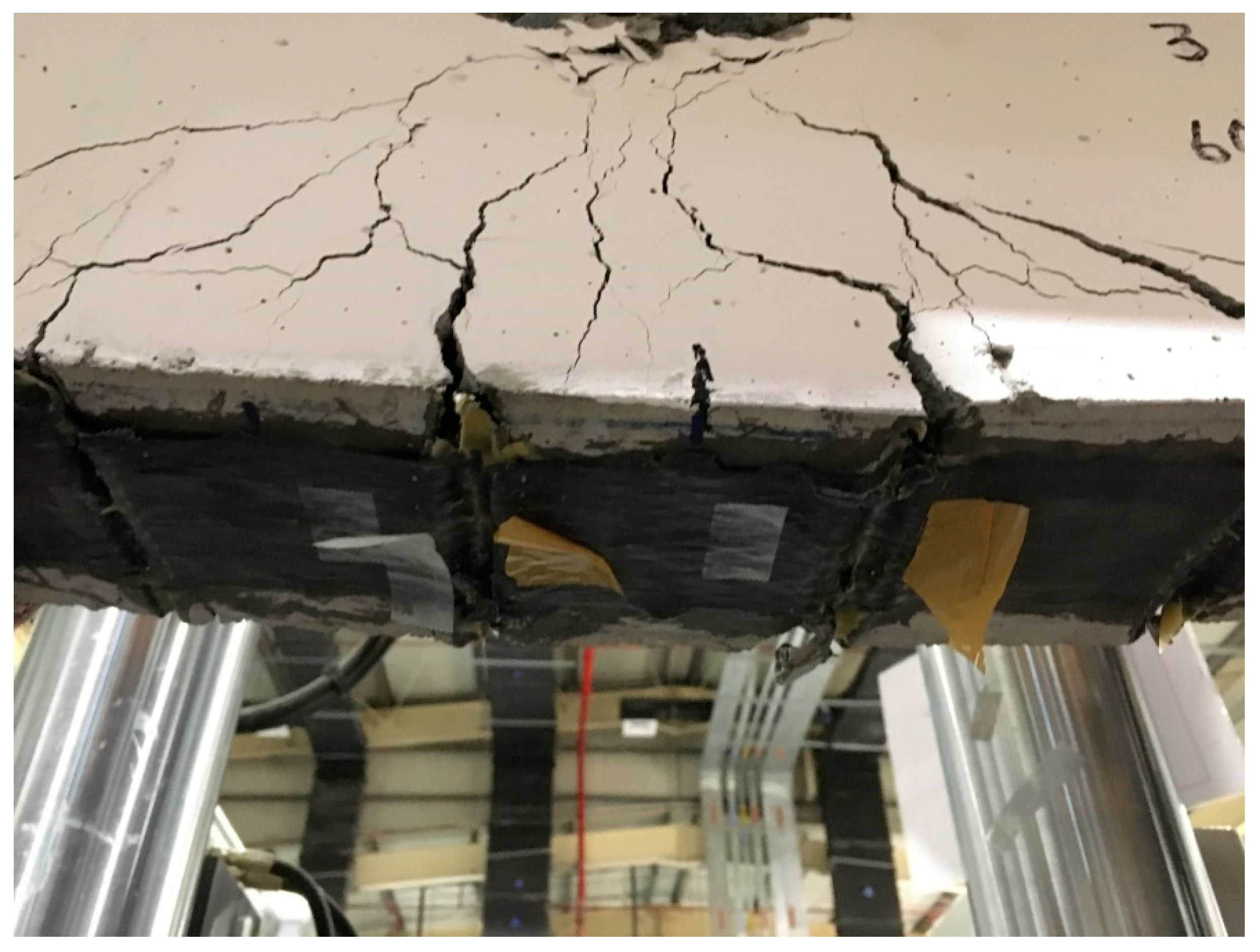
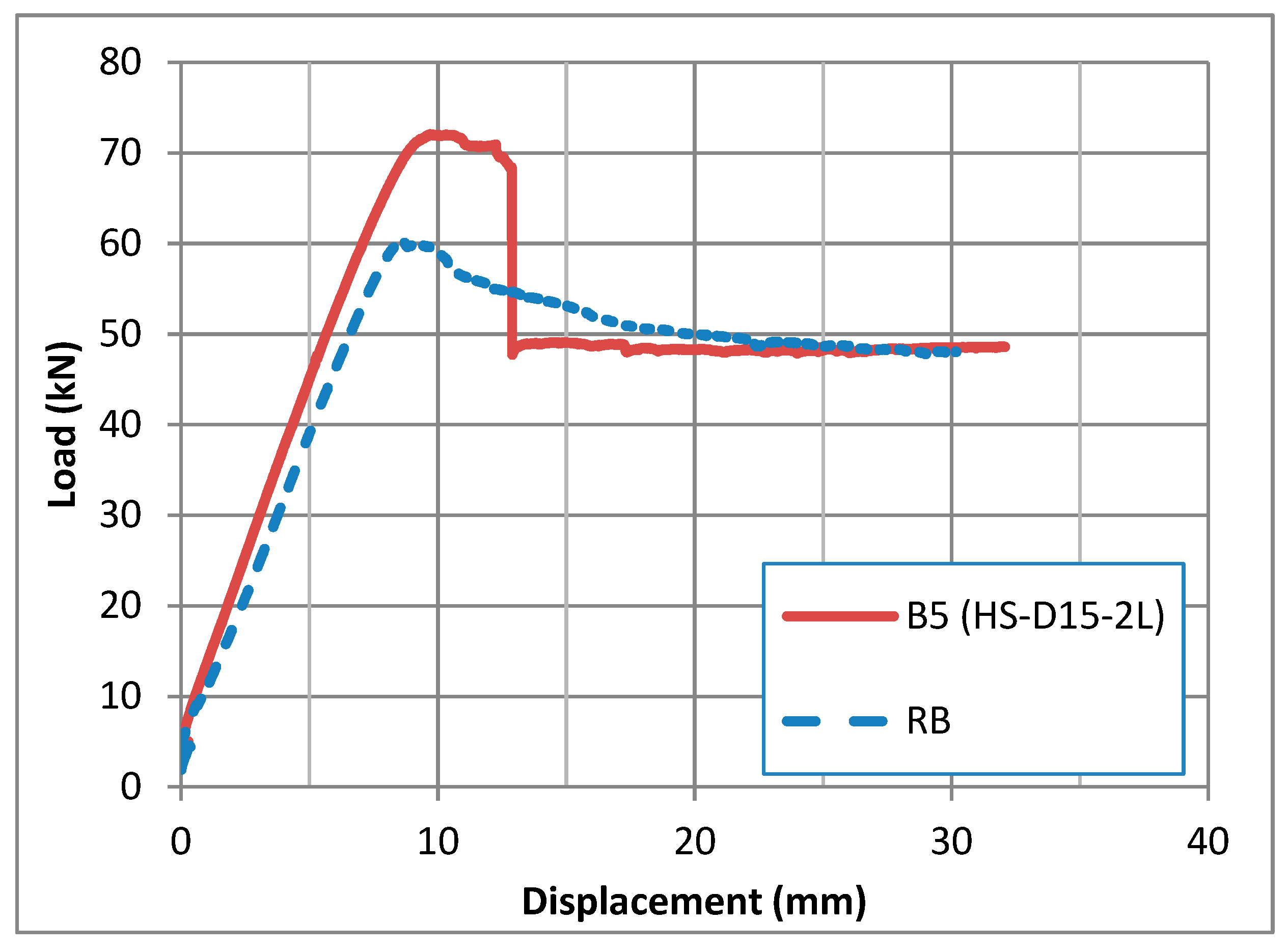


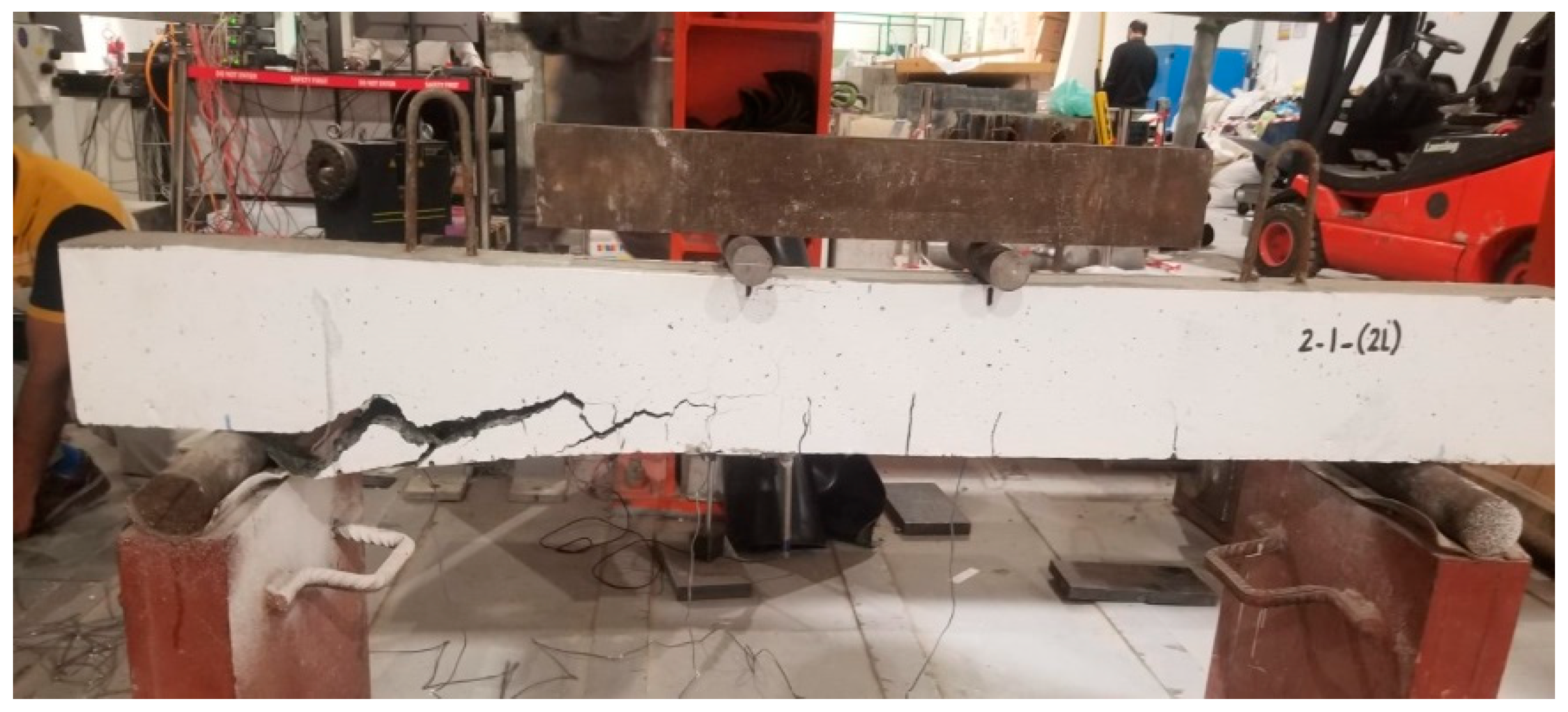
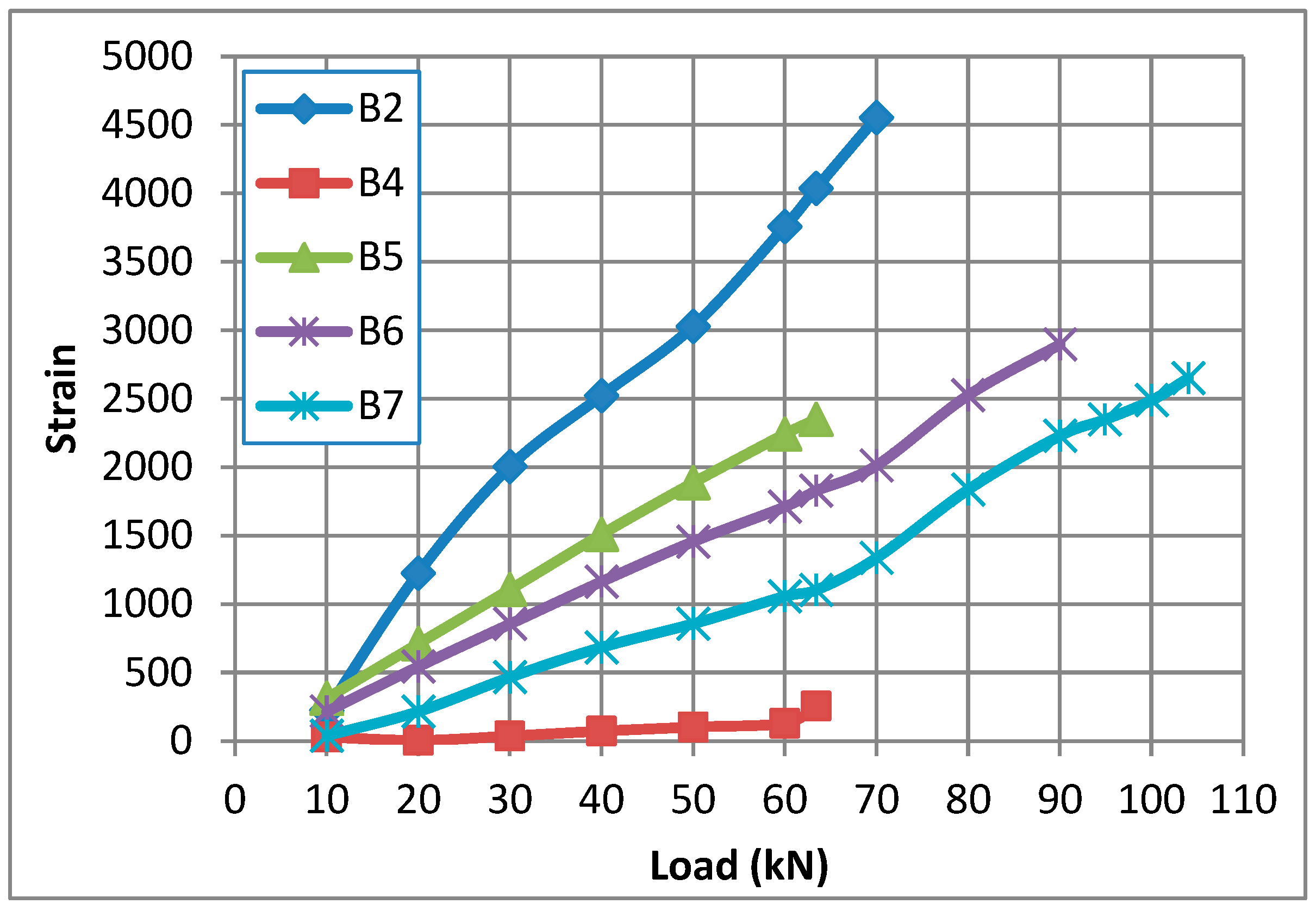
| Beam No. | Designation | Groove Depth (mm) | Groove Width (mm) | Distance Between Grooves (mm) |
|---|---|---|---|---|
| B1 | RB | - | - | - |
| B2 | OG-D10-iL | - | - | 100 |
| B3 | IG-D10-1L | 10 | 8 | 100 |
| B4 | IG-D15-1L | 10 | 8 | 100 |
| B5 | HS-D15-2L | 15 | 8 | 100 |
| B6 | HS-D15-2L(Anchor) | 15 | 8 | 100 |
| B7 | HS-D15-3L(Anchor) | 15 | 8 | 100 |
| Material | Thickness (mm) | Tensile Strength (MPa) | Modulus of Elasticity (GPa) | Elongation at Break (%) |
|---|---|---|---|---|
| CFRP fabric | 0.219 | 4900 | 252 | 2 |
| Material | Dimensions (mm) | Compressive Strength (MPa) | Tensile Strength (MPa) | Modulus of Elasticity (MPa) |
|---|---|---|---|---|
| Concrete | 200 heights × 100 diameter | 42 | 3.64 | 25,900 |
| Adhesive | Compressive Strength (MPa) | Tensile Strength (MPa) | Modulus of Elasticity (MPa) |
|---|---|---|---|
| MapeWrap-31 | 70 | 40 | >3001 |
| Beam No. | Designations | Groove Depth (mm) | Groove Width (mm) | Ultimate Load (kN) | Failure Mode |
|---|---|---|---|---|---|
| B1 | RB | - | - | 60.42 | bending |
| B2 | OG-D10-iL | 10 | 8 | 73.76 | Delamination at Fiber end |
| B3 | IG-D10-1L | 10 | 8 | 61.35 | bending |
| B4 | IG-D15-1L | 15 | 8 | 65.35 | bending |
| B5 | HS-D15-2L | 15 | 8 | 72.00 | Separation of concrete cover |
| B6 | HS-D15-2L(Anchor) | 15 | 8 | 94.93 | Separation of concrete cover |
| B7 | HS-D15-3L(Anchor) | 15 | 8 | 104.27 | Separation of concrete cover |
Disclaimer/Publisher’s Note: The statements, opinions and data contained in all publications are solely those of the individual author(s) and contributor(s) and not of MDPI and/or the editor(s). MDPI and/or the editor(s) disclaim responsibility for any injury to people or property resulting from any ideas, methods, instructions or products referred to in the content. |
© 2025 by the authors. Licensee MDPI, Basel, Switzerland. This article is an open access article distributed under the terms and conditions of the Creative Commons Attribution (CC BY) license (https://creativecommons.org/licenses/by/4.0/).
Share and Cite
Al-Abdwais, A.H.; Al-Tamimi, A.K. Performance of Hybrid Strengthening System for Reinforced Concrete Member Using CFRP Composites Inside and over Transverse Groove Technique. Fibers 2025, 13, 93. https://doi.org/10.3390/fib13070093
Al-Abdwais AH, Al-Tamimi AK. Performance of Hybrid Strengthening System for Reinforced Concrete Member Using CFRP Composites Inside and over Transverse Groove Technique. Fibers. 2025; 13(7):93. https://doi.org/10.3390/fib13070093
Chicago/Turabian StyleAl-Abdwais, Ahmed H., and Adil K. Al-Tamimi. 2025. "Performance of Hybrid Strengthening System for Reinforced Concrete Member Using CFRP Composites Inside and over Transverse Groove Technique" Fibers 13, no. 7: 93. https://doi.org/10.3390/fib13070093
APA StyleAl-Abdwais, A. H., & Al-Tamimi, A. K. (2025). Performance of Hybrid Strengthening System for Reinforced Concrete Member Using CFRP Composites Inside and over Transverse Groove Technique. Fibers, 13(7), 93. https://doi.org/10.3390/fib13070093








